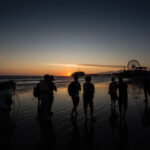
1. Have the subject’s permission
If you find an interesting subject and want to take his/her picture it is not only inconsiderate but can actually go against somebody’s belief or faith if you don’t get their permission first especially if you are capturing their face.
If you want to publish the photo or sell them then you may have to get the person to sign a release form too.
2. Lighting
To shoot a good picture, light is very important. Unless you are a shooting a child when using a flashlight shining from below really can capture a child beautifully, but this technique is not flattering on older subjects.
Soft light works much better. If they are indoors then daylight coming from a window or light coming from a reflector works best.
If shooting outside, it is still advisable to use a little fill flash on the face, or if possible use a reflector (gold ones give a warmer light). If you want to add character to a portrait then using shadow can add a mystical quality.
3. Choosing a lens
When choosing a lens, using an 80-100 tele lens (or zoom) works best for most portraits and helps get rid of unflattering details.
When using a wide angle lens be sympathetic because this type of lens can really distort a face and really make some one nose appear quite large.
 4. Angles
4. Angles
Composition of a picture from an elevated position may be dramatic but the general rule is to hold the camera at the same height as your subjects head.
Also take your subject into account as shooting from the front with the subject nose straight into the lens can make a big nose smaller. Whilst making a small nose larger can be achieved by shooting from a slight angle.
5. The depth of field
In most cases you do not want the background to distract from the subject. If you use a tele lens it reduces the depth of field. You can reduce the field further if you shorten the exposure time and have a wider aperture.
Many very good portraits only show the most important part of the face (usually the eyes) in focus.
6. Filters Even if you want to experiment with filters I would still recommend taking a few unfiltered shots first, then use those starting points as a guide to following photos.
Filters can help achieve the right look by softening or warming the light. In today though a lot can be done at home if you have the right software package and they are several free ones that can be easily downloaded off the web for free.
 In conclusion
In conclusion
Overall there is a lot to consider. It is always important to have your camera at the ready as the moment can pass very quickly and if you aren’t prepared you can miss a great shot. Always be considerate of your surroundings and cultures and make sure taking a picture is appropriate. In some cultures they believe taking someone’s picture means your capture their sole too.
If you are considerate of other people you will find on your travels that people are much more and can also lead to getting a great shot that you never thought possible.
This article was written by Peter Dodds who has been a succesful freelance music photographer for the last eight years in the music capital of London. Peter’s last exhibit “Faith In Geometry” was a great success and was featured in several prominent publications.
Like This Article?
Don't Miss The Next One!
Join over 100,000 photographers of all experience levels who receive our free photography tips and articles to stay current:








Leave a Reply